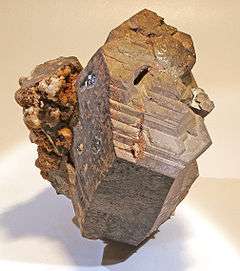Pyrrhotite
| Pyrrhotite | |
|---|---|
|
Pyrrhotite – Santa Eulalia Mine, Chihuahua, Mexico (7,5x7cm). | |
| General | |
| Category | Mineral |
| Formula (repeating unit) | Fe1-xS (x = 0 to 0.2) |
| Strunz classification | 2.CC.10 |
| Crystal system | Monoclinic, with hexagonal polytypes |
| Crystal class |
Prismatic (2/m) (same H-M symbol) |
| Space group | A2/a |
| Unit cell |
a = 11.88 Å, b = 6.87 Å, c = 22.79 Å; β = 90.47°; Z = 26 |
| Identification | |
| Color | Bronze, dark brown |
| Crystal habit | Tabular or prismatic in hexagonal prisms; massive to granular |
| Cleavage | Absent |
| Fracture | Uneven |
| Mohs scale hardness | 3.5 – 4.5 |
| Luster | Metallic |
| Streak | Dark grey – black |
| Specific gravity | 4.58 – 4.65, average = 4.61 |
| Refractive index | Opaque |
| Fusibility | 3 |
| Solubility | Soluble in hydrochloric acid |
| Other characteristics | Weakly magnetic, strongly magnetic on heating; non-luminescent, non-radioactive |
| References | [1][2][3] |
Pyrrhotite is an iron sulfide mineral with the formula Fe(1-x)S (x = 0 to 0.2). It is a nonstoichiometric variant of FeS, the mineral known as troilite. Pyrrhotite is also called magnetic pyrite, because the color is similar to pyrite and it is weakly magnetic. The magnetism decreases as the iron content increases, and troilite is non-magnetic.[4]
Structure
-sulfide-unit-cell-3D-balls.png)
Pyrrhotite exist as a number of polytypes of hexagonal or monoclinic crystal symmetry; several polytypes often occur within the same specimen. Their structure is based on the NiAs unit cell. As such, Fe occupies an octahedral site and the sulfide centers occupy trigonal prismatic sites.[5]
Materials with the NiAs structure often are non-stoichiometric because they lack up to 1/8th fraction of the metal ions, creating vacancies. One of such structures is pyrrhotite-4C (Fe7S8). Here "4" indicates that iron vacancies define a superlattice that is 4 times larger than the unit cell in the "C" direction. The C direction is conventionally chosen parallel to the main symmetry axis of the crystal; this direction usually corresponds to the largest lattice spacing. Other polytypes include: pyrrhotite-5C (Fe9S10), 6C (Fec11S12), 7C (Fe9S10) and 11C (Fe10S11). Every polytype can have monoclinic (M) or hexagonal (H) symmetry, and therefore some sources label them, for example, not as 6C, but 6H or 6M depending on the symmetry.[1][6] The monoclinic forms are stable at temperatures below 254 °C, whereas the hexagonal forms are stable above that temperature. The exception is for those with high iron content, close to the troilite composition (47 to 50% atomic percent iron) which exhibit hexagonal symmetry.[7]
Magnetic properties
The ideal FeS lattice, such as that of troilite, is non-magnetic. Magnetic properties vary with Fe content. More Fe-rich, hexagonal pyrrhotites are antiferromagnetic. However, the Fe-deficient, monoclinic Fe7S8 is ferrimagnetic.[8] The ferromagnetism which is widely observed in pyrrhotite is therefore attributed to the presence of relatively large concentrations of iron vacancies (up to 20%) in the crystal structure. Vacancies lower the crystal symmetry. Therefore, monoclinic forms of pyrrhotite are in general more defect-rich than the more symmetrical hexagonal forms, and thus are more magnetic.[9] Upon heating to 320 °C, pyrrhotite loses its magnetism, but also starts decomposing to magnetite. The saturation magnetization of pyrrhotite is 0.12 tesla.[10]
Occurrence
Pyrrhotite is a rather common trace constituent of mafic igneous rocks especially norites. It occurs as segregation deposits in layered intrusions associated with pentlandite, chalcopyrite and other sulfides. It is an important constituent of the Sudbury intrusion where it occurs in masses associated with copper and nickel mineralisation.[7] It also occurs in pegmatites and in contact metamorphic zones. Pyrrhotite is often accompanied by pyrite, marcasite and magnetite. Pyrrhotite does not have specific applications. It is mined primarily because it is associated with pentlandite, sulfide mineral that can contain significant amounts of nickel and cobalt.[1]
Etymology and history
The name pyrrhotite is derived from Greek pyrrhos, flame-colored.[1]
Issues
Pyrrhotite has been linked to crumbling concrete basements in Quebec and Connecticut when local quarries included it in their concrete mixtures. The iron sulfide it contains can react with oxygen and water over time to cause swelling and cracking.[11][12]
References
- 1 2 3 4 "Pyrrhotite". Mindat.org. Retrieved 2009-07-07.
- ↑ "Pyrrhotite" (PDF). Rruff.geo.arizona.edu. Retrieved 2015-07-10.
- ↑ "Pyrrhotite Mineral Data". Webmineral.com. Retrieved 2015-07-10.
- ↑ Vaughan, D. J.; Craig, J. R. "Mineral Chemistry of Metal Sulfides" Cambridge University Press, Cambridge: 1978. ISBN 0521214890.
- ↑ Shriver, D. F.; Atkins, P. W.; Overton, T. L.; Rourke, J. P.; Weller, M. T.; Armstrong, F. A. "Inorganic Chemistry" W. H. Freeman, New York, 2006. ISBN 0-7167-4878-9.
- ↑ Barnes, Hubert Lloyd (1997). Geochemistry of hydrothermal ore deposits. John Wiley and Sons. pp. 382–390. ISBN 0-471-57144-X.
- 1 2 Klein, Cornelis and Cornelius S. Hurlbut, Jr., Manual of Mineralogy, Wiley, 20th ed, 1985, pp. 278-9 ISBN 0-471-80580-7
- ↑ Sagnotti, L., 2007, Iron Sulfides; in: Encyclopedia of Geomagnetism and Paleomagnetism; (Editors David Gubbins and Emilio Herrero-Bervera), Springer, 1054 pp., p. 454-459.
- ↑ Atak, Suna; Önal, Güven; Çelik, Mehmet Sabri (1998). Innovations in Mineral and Coal Processing. Taylor & Francis. p. 131. ISBN 90-5809-013-2.
- ↑ Svoboda, Jan (2004). Magnetic techniques for the treatment of materials. Springer. p. 33. ISBN 1-4020-2038-4.
- ↑ "With Connecticut Foundations Crumbling, Your Home Is Now Worthless". nytimes.com. Retrieved 2016-06-08.
- ↑ "Crumbling Foundations". nbcconnecticut.com. Retrieved 2016-06-08.
External links
-
 Spencer, Leonard James (1911). "Pyrrhotite". Encyclopædia Britannica (11th ed.).
Spencer, Leonard James (1911). "Pyrrhotite". Encyclopædia Britannica (11th ed.).
